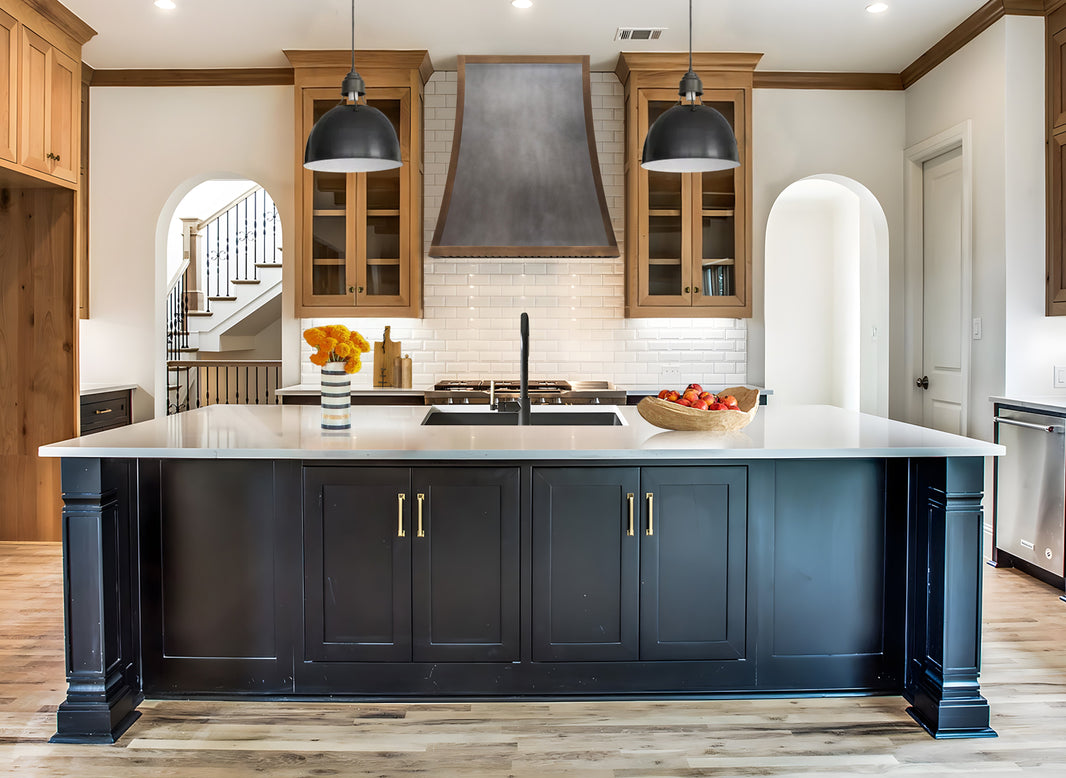Core Advantage Comparison of Range Hoods by Four Materials
-
Stainless Steel Range Hoods: Practicality-First Choice
Core Advantages:
• High Durability: Resistant to corrosion and high temperatures. Even in kitchens with frequent high-heat cooking, it can last 8–10 years without deformation or rust.
• Easy Cleaning: Features a smooth, mirror-like surface that wipes clean of oil stains in one go. Unlike copper, it doesn’t require frequent polishing and maintenance—ideal for busy households.
• Cost-Effective: Covers a wide price range, from under $200 to over $800. Whether for rental apartments or fully renovated homes, there are suitable models available.
• Versatile Styling: Its silver metallic finish seamlessly blends with various kitchen designs, such as modern, minimalist, and industrial styles. -
Copper & Brass Range Hoods: Retro Aesthetic Choice
Core Advantages:
• Premium Appeal: Copper inherently has a warm, lustrous finish that develops a unique patina over time. Brass, with its golden hue, exudes elegance—making both top choices for villas and retro-themed kitchens.
• Natural Antibacterial Property: Copper ions have natural antibacterial effects. Tests show that the bacterial survival rate on copper surfaces is 90% lower than on stainless steel, making it friendly for households with high hygiene standards.
• Superior Craftsmanship Potential: Can be crafted with intricate details like hammered textures and carved patterns. -
Zinc Range Hoods: Budget-Friendly "Temporary Option"
Core Advantages:
• Lowest Price: Made from low-cost raw materials, it’s suitable for short-term renters or those with extremely limited budgets.
• Lightweight Design: 30% lighter than stainless steel, reducing load requirements on cabinetry in older homes.
Target User Profiles by Material
| Material | Stainless Steel | Copper/Brass | Zinc |
| Core Target Users | Household kitchens, commercial kitchens | Villa owners, retro-style enthusiasts, high-end texture seekers | Short-term renters, temporary users |
| Typical Application Scenarios | Family kitchens (daily cooking), restaurant backyards | American country-style kitchens, open-concept kitchen islands | Rental apartments, temporary kitchen renovations |
Which Material Truly Dominates? Answer: Stainless Steel Range Hoods
According to market data, stainless steel range hoods hold over 70% of the market share—far exceeding the combined share of copper (3%), brass (2%), and zinc (5%).
Three Core Reasons:
-
Meets "High-Frequency Use" Needs of Modern Kitchens:
Its oil-resistant and heat-resistant properties handle diverse cooking scenarios (e.g., oven baking, open-flame grilling) with ease. In contrast, copper requires regular polishing, and zinc deforms easily under prolonged high temperatures—neither can keep up with 3–5 daily cooking sessions per household. -
Covers All Consumer Budgets:
It offers options for every price point, from basic models ($150–$300) for apartments to high-end smart custom models ($1,000–$3,000) for villas. Copper range hoods, however, often cost over $5,000, limiting them to a niche high-end market. -
Matches Mainstream Kitchen Styles:
Stainless steel’s metallic texture naturally complements popular North American kitchen designs, such as modern minimalist, industrial, and farmhouse styles. Its silver tone pairs well with white cabinetry, dark countertops, and other color schemes. Copper only fits specific retro styles, while zinc’s colored coatings tend to look cheap.
Unless there is a clear need for high-end retro decor or a short-term temporary solution, stainless steel range hoods remain the absolute mainstream choice in the U.S. market. Their durability, easy maintenance, and design versatility perfectly align with the American household preference for practical, long-lasting kitchen appliances.




